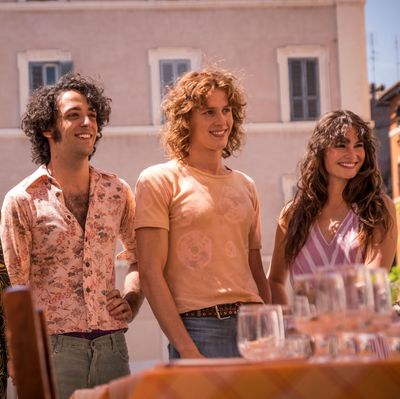
Yet another strong episode, “La Dolce Vita” fills in the chronological gaps about the kidnapping of John Paul Getty III. We’ve seen everything but the kidnapping so far, focusing more on Donald Sutherland’s John Paul Getty, Hilary Swank’s Gail Getty, and Brendan Fraser’s Fletcher Chace, and this episode constantly brings us back to images we’ve seen — Paul going to visit his grandfather, Paul dancing at the club, the gunfire that opened the second episode — placing them in context of the greater picture overall. We also learn that, at least according to this version of events, none of it might have happened if an Italian restaurant owner had just met Roman Polanski.
The episode begins in a sound vacuum that’s invaded by Curved Air’s “Back Street Luv,” as the opening montage sets the background for everything that we’ll see in Italy: drugs, sex, and the kind of behavior that John Paul Getty generally abhors. While revolution rages in the street, chaos is the theme of the day for young people who fight and screw and party. The fantastic music selections slide from Curved Air into “Easy Livin’” by Uriah Heep and into “Ballroom Blitz” by Sweet. It’s a ‘70s youth-rebellion montage. La dolce vita, indeed.
The violence isn’t only in the streets of Rome, as we’re introduced to the true villain of Trust in a harrowing home-invasion scene. The owners have been bound and gagged as two men ransack their house. After the underling says the name of the man in charge, Primo, the big bad guy shoots all three people in the room — the two homeowners and his partner in crime — and lights the place on fire. This guy is nuts, and he’s about to cross paths with the Gettys.
Berto, the owner of the café adorned by Paul’s art who Fletcher Chace found in last week’s episode, is brought the semi-kidnapped boy, who apologizes before getting thrown in the trunk. It won’t be the last time Paul flashes back to how he got here from the boot of a car. The young man flashes to all of the debauchery of recent days, and we learn how the heir to one of the wealthiest empires in the world was actually broke. He was “no food broke.” Paul’s protestations that “love will provide” were starting to annoy his friends, but he took a couple paintings to sell to Berto for more, including one of his adorable dog.
As Paul’s friends got in his ear about leaning on the Getty name for money, Berto’s colleagues pointed out how much the young man owes him. If you’re starting to wonder just how four young people could eat $6,000 worth of food, you’re not alone. We learn later that it wasn’t just sustenance Berto was providing, but cocaine, and that he was promised that the Getty name would eventually pay the hefty nose-candy tab. And we learn that Berto also owes money himself. This remind anyone else of John Paul’s “money spider” business model from episode one? The idea is that John Paul pays his grandson, who pays Berto, who pays whomever Berto owes, and on and on. Everybody pays.
These young hippies certainly don’t make Berto happy when Marcello tells him to meet at the club called Treetops, where he’ll get to hang with Roman Polanski. We see Berto getting ready and getting excited, only to be shut out of the club and stepping in dog shit. Berto is having a bad few days, and Trust seems to be arguing that shutting him out of the “cool kids scene” influenced the pressure that he’d place on Paul and his friends to pay his debt. It really got the ball rolling for the kidnapping.
Berto comes to the flat the next morning, demanding that the $6,000 be paid, and this is where Paul learns for the first time that his friends have been racking up debt on the Getty name. They presumed Paul could pay it with a snap of his fingers. Berto puts his goons in the room to threaten Paul’s friends (and lead to the attempted rape and gunfire that opened last week’s episode) and sends the Getty boy out to get his money. Paul first goes to his mother, but the man in Gail’s life pushes him away with his asshole behavior. And then, of course, we know that Paul went to his grandfather, a scene that we saw in episode one. And then we’re back to the trunk. It’s all connected. Only Danny Boyle can jump chronologically this fluidly. It’s remarkably well-constructed.
Now we’re back with Paul in the sunflower field where the series opened, but a few questions remain — and “La Dolce Vita” gets more chronologically fractured than ever as it answers them. Breaking it all down and piecing it back together, the episode tells us that Paul’s roommates racked up debt to a local restaurant owner for drugs and then the restaurant owner and the billionaire’s grandson cooked up a scheme. They staged a fake kidnapping, from which Paul briefly escaped when claustrophobia and drug addiction got the best of him. Then Berto, tired of the games and angry about the escape, basically sold the fake kidnapping to a real kidnapper named Primo, who killed Berto and threw Paul in a trunk with his body. The way all of this unfolds is mesmerizing, cutting back and forth between Paul scrambling to get the money, planning the kidnapping with Berto, and basically being sold to someone else. And yet we’re reminded that Paul was an optimistic dreamer in so many of these scenes, such as when he’s asking Martina to marry him. It’s a great moment, set in front of the Colosseum in Rome, a beautiful symbol of a crumbling, lost culture.
In many ways, “La Dolce Vita” is the best and worst of Trust. If you think the show is too fractured and manically edited, this episode likely pushed you over the edge. But if you’re engaged by Danny Boyle and writer Simon Beaufoy’s ambitious style, this episode has it all: crosscutting through time, a dozen or so rock-music cues, canted angles, emotional close-ups, hyperactive editing. In a sense, the episode reflects those opening scenes throughout with its filmmaking — sex, drugs, and chaos in the streets, totally captured in its style. And John Paul Getty III is about to get destroyed by all of it.
Other Notes
• We’ve reached the big question: DID John Paul Getty III plan his own kidnapping? Simon Beaufoy, who did a lot of research for Trust, thinks he did. He told Variety, “It became clear reading between the lines that he actually kidnapped himself. It was a hoax gone wrong … He’d run up a debt, quite a large debt, and couldn’t repay it.” The Getty family disagrees. John Paul Getty III died in 2011, so we’ll likely never know.
• I’ve praised the editing over the first three weeks, so let’s give some credit to the man behind it, Elliot Graham, who also cut together Molly’s Game and Steve Jobs. He really likes to jump around chronologically.
• Let’s go through a few of the great music cues this week: “Tu Vuo Fa L’americano” by Renato Carosone, when Paul is selling his paintings to Berto; “Silver Machine” by Hawkwind, at the club Treetops when Berto is left outside; “Eclipse” by Pink Floyd, as Paul explains the plan and writes the ransom letter; “Why Can’t We Live Together” by Timmy Thomas, played over the closing credits.


